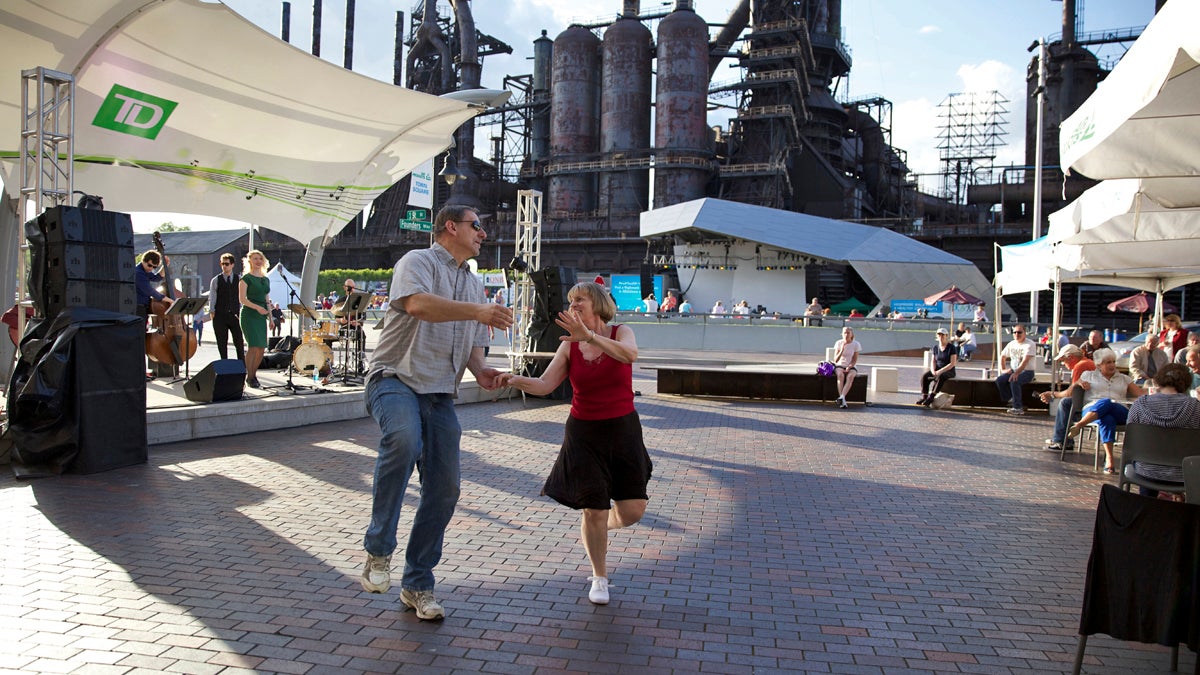Ideas Worth Stealing: Have an old place tell a new story

Jim Jacek and Kathy Fox dance during a free jazz performance outside of ArtsQuest and the Levitt Pavilion at SteelStacks
How can cities and developers decide which buildings and sites are worth saving?
That was one of the driving questions during our panel discussion on historic preservation at Keystone Crossroads’ first Urban Ideas Worth Stealing conference.
To start, you need a place that tells a story about a region — ideally one a lot of people would connect with. For example, SteelStacks is a 10-acre arts campus and concert space in Bethlehem built on the ground of a former steel mill. A lot of people in this region have family members who were industrial workers, and those people will make the trip to Bethlehem to see some piece of that history preserved.
But historic value, on its own, isn’t enough. If you’re only thinking about that, you’ll end up opening a lot of one-room museums that people only visit once, said Mindy Crawford, executive director of Preservation Pennsylvania and one of our panelists.
Instead, to make preservation worth doing, cities and developers should imagine what a site could become, what niche it fills, and how its restoration could generate revenue or create jobs. Jeff Parks, the founder of SteelStacks and one of our panelists, said the site shows films and concerts that the region wasn’t offering.
Panelist Paul Steinke, who’s the executive director of the Preservation Alliance in Philadelphia, also talked about how, when done right, historic preservation can draw in young professionals. You know, the ones who use Pinterest, have a thing for exposed brick, and are exactly the kind of people cities are hoping to lure in to expand their tax base.
When we asked some of the millenials in the audience about that idea, we heard that historic preservation has another appeal to them: it can be more environmentally sustainable than building new. But at the same time, a lot of millenials don’t have the money to buy homes yet. So we may be talking more about the renters’ market.
It’s also important to think about preservation in terms of a region’s history. Pennsylvania has a lot of old industrial sites — places we might not consider beautiful or historically valuable. SteelStacks turns that idea on its head.
The site repurposed the steel mill’s blast furnaces as an art installation. But Parks wasn’t always planning to do that. He initially wanted to tear the furnaces down.
Then he visited Landschaftspark Duisburg-Nord, a former coal and steel production plant in the Ruhr region of Germany. It’s now home to a cultural park, with walking and bike paths, a beer garden and restaurant, a visitor platform on top of a blast furnace, and a multicolored light installation that illuminates the site at night. After seeing Landschaftspark, Parks decided to keep the blast furnaces, and now it’d be hard to imagine SteelStacks without them.
Landschaftspark is one of many industrial sites in the Ruhr that have been turned into parks.
The point is to consider the unique attributes of a particular space and whether they help tell a story about the region. You can’t save everything, as we discussed, but you shouldn’t write off history just because it’s not conventionally beautiful, either.
WHYY is your source for fact-based, in-depth journalism and information. As a nonprofit organization, we rely on financial support from readers like you. Please give today.


